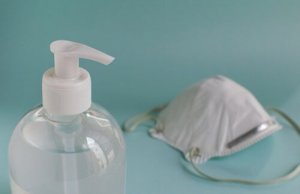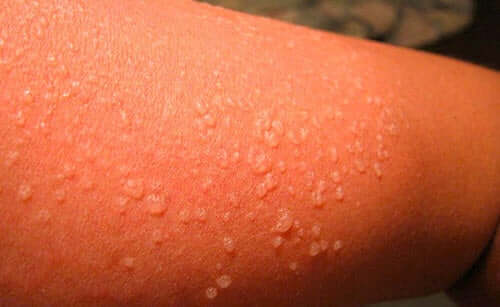How Coronavirus Affects the Skin


Written and verified by the doctor Leonardo Biolatto
The main sign of COVID-19 is difficulty breathing. However, evidence also exists that suggests that coronavirus affects the skin and other organs in our body as well.
Let’s remember that the classic triad of symptoms in the case of SARS-CoV-2 includes fever, cough, and fatigue, which can lead to shortness of breath. Some patients also claim to have experienced a loss of their sense of smell and reddening of the eyes.
The catalog of symptoms of the current pandemic has been a topic of debate since the beginning. Sometimes, health professionals warn about associated signs, but medical associations have yet to include them in their protocols. In other cases, medical associations release communications asking patients to be examined according to new criteria, but the WHO rejects their requests.
This contradictory situation is typical of a developing pandemic. We have yet to discover the final extent of COVID-19, and we still don’t know if there will be reinfections. Nor do we know if there will be new waves of infection, as experts are already speculating in China where authorities were relaxing the strictest quarantines.
And this brings us to the dermatological aspect of SARS-CoV-2, which we must consider from two different perspectives. First, we must look at how coronavirus affects the skin directly. And second, we must look at the consequences that quarantine has on our skin. We’ll go into detail regarding both in the paragraphs below.
Does coronavirus affect the skin?
Dermatologists around the world agree that the SARS-CoV-2 virus is not dermotropic. This means that coronavirus does not affect the skin directly or, in other words, it doesn’t settle into the cells of the skin.
However, a letter to the editor of the Journal of the European Academy of Dermatology and Venereology on behalf of an Italian dermatologist reported cutaneous symptoms among patients hospitalized with COVID-19. According to this letter, 20% of the patients this professional examines had one of the following symptoms:
- Erythematosus rash
- Hives
- Blisters
These skin blisters appeared during their hospitalization or afterward, but were unrelated to the severity of the infection.
The warning from the Italian dermatologist had more to do with the protection that’s necessary in order to avoid contagion. While he recognizes that the virus has been proven to spread through respiratory droplets, he also insists on the use of physical barriers to prevent contact with possible associated lesions.

Keep reading: The Coronavirus Pandemic: Understanding the Terminology
How coronavirus affects the skin indirectly through quarantine
The problems that coronavirus may cause in the skin have to do with more than the infection itself. Quarantine also has dermatological consequences, as it leads to disorders that have to do with confinement. What’s more, the constant use of cleaning products, and the lack of exposure to sunlight, also has negative results.
We can say that, in this sense, the coronavirus pandemic affects the skin indirectly. For example, there have been cases of dermatitis as a result of excessive handwashing and the abuse of hand sanitizer. At the same time, some individuals have reported pressure sores as a result of being in the same position for long periods of time.
Skin irritation as a result of the use of cleaning products is nothing new. Chemical irritation has always been a cause of dermatitis. The current problem is the exacerbation of the use of these products. Some people obsess over handwashing and use excessive amounts of disinfectant products.
On top of this, we must also mention the lack of exposure to direct natural sunlight as another consequence of quarantine. When spending so much time indoors, it’s impossible to catch enough ultraviolet rays, reducing our vitamin D levels.
Vitamin D plays a key role in the health of our skin, protecting our dermatological cells and their metabolism. Therefore, people should try to get as much exposure to sunlight as possible. If you can’t get outdoors, then go out on your balcony or open a window and allow the sun to shine on your skin for at least a few minutes a day.

Discover more: How Long Does Coronavirus Last on Different Surfaces?
The skin of health workers
Another important point to consider when talking about how coronavirus affects the skin has to do with medical personnel. Given the protective equipment that doctors and nurses must wear, their skin suffers.
The recommended PPE that is part of the current protocol consists of gloves, masks, a gown, and a scrub hat. And these can lead to dermatitis and skin irritation on a person’s face and hands. What’s more, an individual’s scalp may develop folliculitis and seborrheic dermatitis.
It’s important for medical personnel to follow a skincare routine once they remove their protective gear. This should involve washing their hands correctly in order to remove latex and other substances that the gloves leave behind. However, a complete shower is most recommended.
The use of hydrating creams can also help to protect the skin, but hospitals don’t usually supply them. According to the studies we cited above, only 22% of doctors and nurses apply hydrating creams at the end of their shifts.
Coronavirus affects our skin and it affects our habits
Whether directly or indirectly, coronavirus affects our skin. Perhaps it’s an effect of the infection on the skin’s own cells, but it’s more likely an effect that results from protective measures. Either way, it’s clear that COVID-19 is changing our habits. Hopefully, the good habits we learn from all of this will last.
All cited sources were thoroughly reviewed by our team to ensure their quality, reliability, currency, and validity. The bibliography of this article was considered reliable and of academic or scientific accuracy.
- Darlenski, Razvigor, and Nikolai Tsankov. “Covid-19 pandemic and the skin-What should dermatologists know?.” Clinics in Dermatology (2020).
- Elston, Dirk M. “Letter from the Editor: Occupational skin disease among healthcare workers during the Coronavirus (COVID-19) epidemic.” Journal of the American Academy of Dermatology (2020).
- María, Macias. “Study on relationship between Vitamin D and risk for various diseases.” Archivos Latinoamericanos de Nutrición 70.3 (2020).
- Yan, Yicen, et al. “Consensus of Chinese experts on protection of skin and mucous membrane barrier for healthcare workers fighting against coronavirus disease 2019.” Dermatologic Therapy (2020): e13310.
- Recalcati, S. “Cutaneous manifestations in COVID‐19: a first perspective.” Journal of the European Academy of Dermatology and Venereology (2020).
This text is provided for informational purposes only and does not replace consultation with a professional. If in doubt, consult your specialist.








